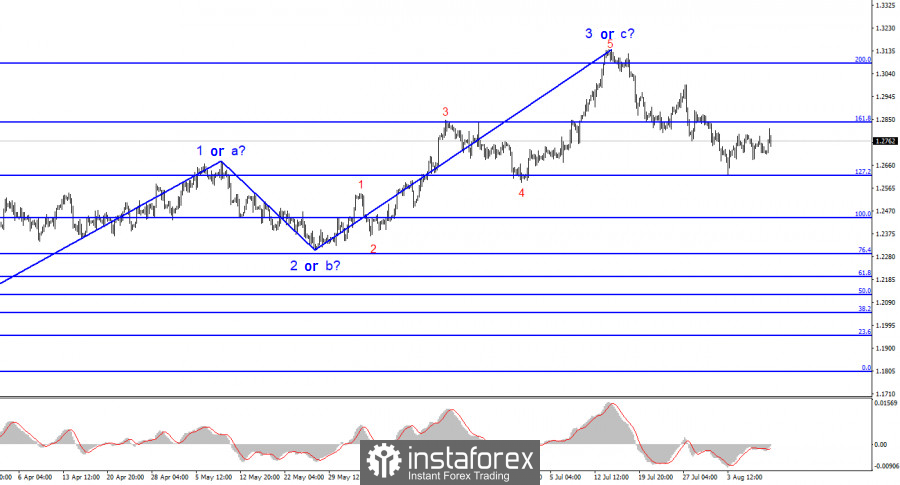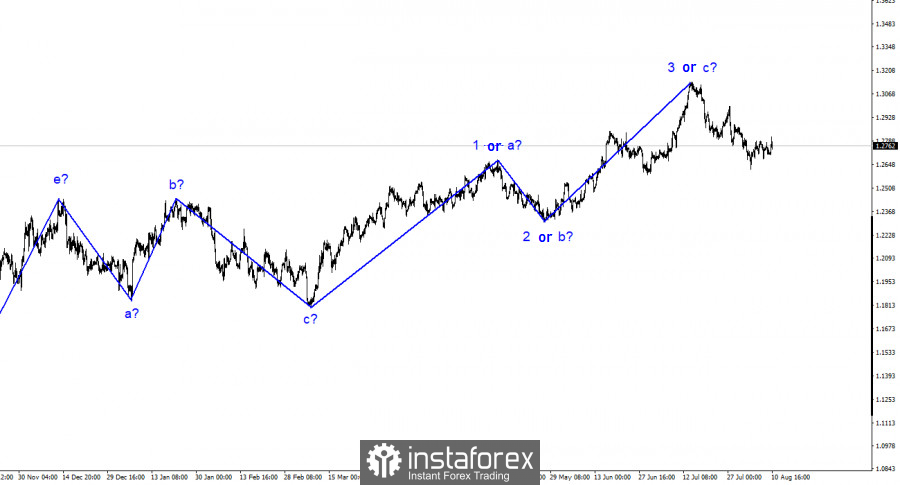

For the GBP/USD pair, the wave pattern remains fairly simple and clear. The construction of the upward wave 3, or possibly wave C, is complete, and a new downward trend segment has begun, which could theoretically still be the fourth wave. The pound has no basis for resuming its rise (and many reports and events support my view). However, the wave pattern has transformed into something more complex, and wave 3 or C has taken on a more extended form than many analysts expected a few months ago. The entire upward trend segment could take on a five-wave form if the market finds new reasons for long-term purchases.
In any case, I expect the continuation of the downward wave that began on schedule. Even if this is the fourth wave of an upward wave set, it should be extended or three-wave. Three waves can already be traced within it, but if the current wave is the fourth, we should receive clear signals about the market's readiness to buy. If the current wave adopts a five-wave internal structure, it can be considered the first impulsive wave, and we can anticipate a further fall in the pound.
The 1.2616 mark held the pound from falling.
The GBP/USD rate increased by 55 basis points on Thursday. For the first time this week, the market received significant data that could be analyzed, conclusions drawn, and the results transferred to terminals. As we can see, within just an hour or so, demand for the US currency sharply increased and then sharply decreased. This tells me the market needed to prepare for such US inflation data. The 3.2% y/y figure doesn't change anything for the dollar or the Fed. In the last 14 months, this is only the first acceleration in the Consumer Price Index. One shouldn't make sweeping conclusions based on just one month.
The second report of the day was the initial unemployment claims in the US, and it's worth noting that it surprised the markets. Instead of 230,000, there were 248,000 claims, indicating rising unemployment. However, the last unemployment report showed a decrease. But that was for June, and it's now August. Therefore, we can again expect an increase in the main unemployment indicator in July and August, though not by much. Currently, it stands at 3.5%, which is only 0.1% above the 50-year minimum. Thus, the unemployment claims slightly disappointed dollar buyers, but they need more to start massively offloading the US currency.

The wave pattern for the GBP/USD pair suggests a decline. My readers could have opened sell positions, which I recommended several weeks ago. The target was the 1.2618 mark, and it has been successfully reached. There's a risk of the current downward wave concluding if it is wave d. In this case, the construction of wave 5 has already started from the current levels. There are more likely scenarios than this. A successful attempt to break through 1.2616 (or an unsuccessful one at 1.2840) will indicate the market's readiness to continue the construction of a downward wave. This is the scenario I'm betting on.
The picture is similar to the EUR/USD pair on a larger wave scale, but some differences remain. The downward corrective segment of the trend is complete, and the construction of a new upward segment is ongoing, which might have already been completed or might take on a full five-wave form.